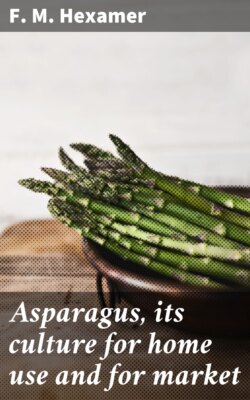Читать книгу Asparagus, its culture for home use and for market - F. M. Hexamer - Страница 13
AMERICAN VARIETIES
ОглавлениеBarr's Mammoth (Barr's Philadelphia Mammoth).—Originated with Crawford Barr, a prominent market gardener of Pennsylvania. It is one of the earliest varieties, is very productive, and grows to the largest size. In Philadelphia it is much sought after, and brings the highest prices.
Conover's Colossal (Van Siclen's Colossal).—Originated with Abraham Van Siclen, of Long Island, N. Y., and was introduced by S. B. Conover, a commision merchant of West Washington Market, New York City, some thirty years ago. The superiority of this variety over all other kinds known at that time made it soon supplant all other varieties, and it is to this day better and more favorably known than any other sort.
Columbian Mammoth White.—This was introduced by D. M. Ferry & Co., in 1893. The immense shoots are clear white, and, in favorable weather, remain so until three or four inches above the surface, without earthing up or any other artificial blanching. The crown or bud of the young stalk is considerably smaller than the part just below it, thus further distinguishing the variety. All but a very few of the seedlings will produce clear white shoots, and the green ones can be readily distinguished and rejected when planting the permanent bed.
Donald's Elmira.—Originated by A. Donald, Elmira, N. Y., and was first introduced by Johnson & Stokes, Philadelphia, Pa. This is characterized by the delicate green color of its stems, different from any other kind. Its stalks are very tender and succulent, while its size is all that can be desired.
Eclipse (Dreer's Eclipse).—A light green mammoth strain of excellent quality and attractive appearance. The stalks, not rarely, measure two inches in diameter, and even when twelve to fifteen inches long are perfectly tender and of a delicate light green color.
Hub.—Originated in New Hampshire several years ago, and was introduced by Joseph Breck & Sons, Boston, Mass. Although not generally catalogued, it is a distinct and valuable variety that has made a decided record for itself in the tests of the Kansas Experiment Station, where its yield, by weight, was greater than any other.
Mammoth.—This is a somewhat indefinite term, as almost any prominent seedsman and grower who has a particularly good and large strain of asparagus suffixes it to his own name. Among the best known of these are Vick's Mammoth, Maule's Mammoth, Prescott's Mammoth, etc.
Moore's Cross-bred.—This originated with J. B. Moore, who for twenty years was awarded the first prize on asparagus at the exhibitions of the Massachusetts Horticultural Society, at one of which the weight of twelve stalks was 4 pounds 6-1/4 ounces. It retains the head close until the stalks are quite long, and is of uniform color, while for tenderness and eating quality it is excelled by none. It is particularly recommended for cultivation in New England.
Palmetto.—A variety of Southern origin, but suitable for the North also. At the South it is somewhat earlier than Conover's Colossal, but its great advantage is that it is almost destitute of, what dealers call, culls, nearly all shoots being of a uniform and large size. The bunch from which the engraving (Fig. 12) was made measured twenty-two inches in circumference, and contained forty-eight stalks of nine inches in length and remarkably uniform in size. It was taken on March 30th from a field of fifty acres, near Charleston, S. C. But the greatest point in its favor is its comparative security from the attacks of rust.
FIG. 12—BUNCH OF PALMETTO ASPARAGUS
Purple Top and Green Top.—These were the only distinct sorts in cultivation before the introduction of Conover's Colossal, but are now almost unknown to the trade and cultivators.
